Project Management Report: Talent Management Strategies for Tesco
VerifiedAdded on 2023/01/03
|23
|5031
|79
Report
AI Summary
This report provides a comprehensive analysis of project management, specifically focusing on talent management strategies within Tesco, a multinational retail company. The report begins by outlining project aims and objectives, emphasizing the importance of attracting and retaining a high-quality workforce. It then details a project management plan covering costs, timelines, quality assurance, communication strategies, risk assessments, and resource allocation. A work breakdown structure and a Gantt chart are presented to illustrate project phases and timelines. The research methodology incorporates both primary and secondary research methods, including questionnaires administered to Tesco employees. The report presents findings and data, followed by recommendations based on the research, and concludes with a reflection on the project's value and the student's learning outcomes.
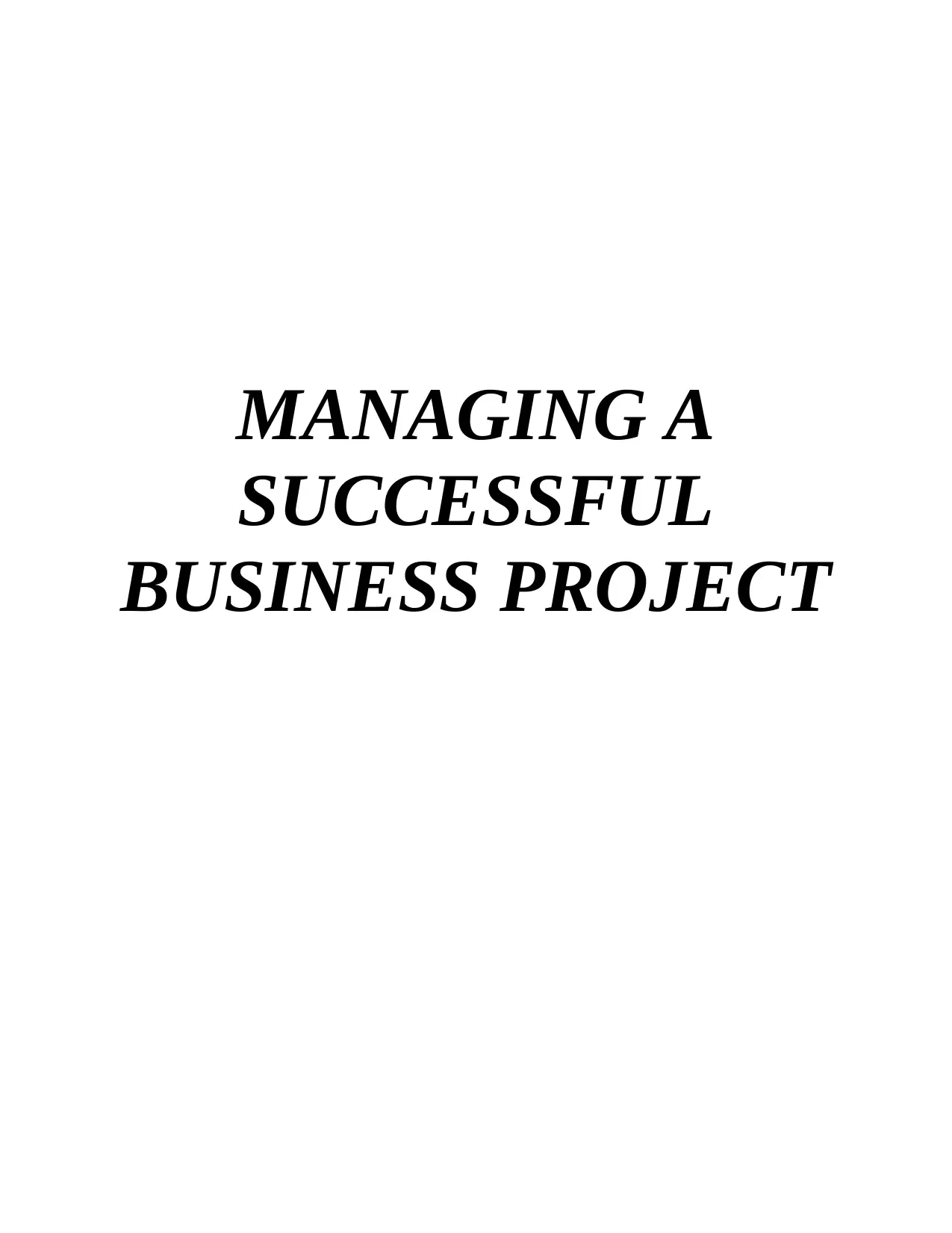
MANAGING A
SUCCESSFUL
BUSINESS PROJECT
SUCCESSFUL
BUSINESS PROJECT
Paraphrase This Document
Need a fresh take? Get an instant paraphrase of this document with our AI Paraphraser
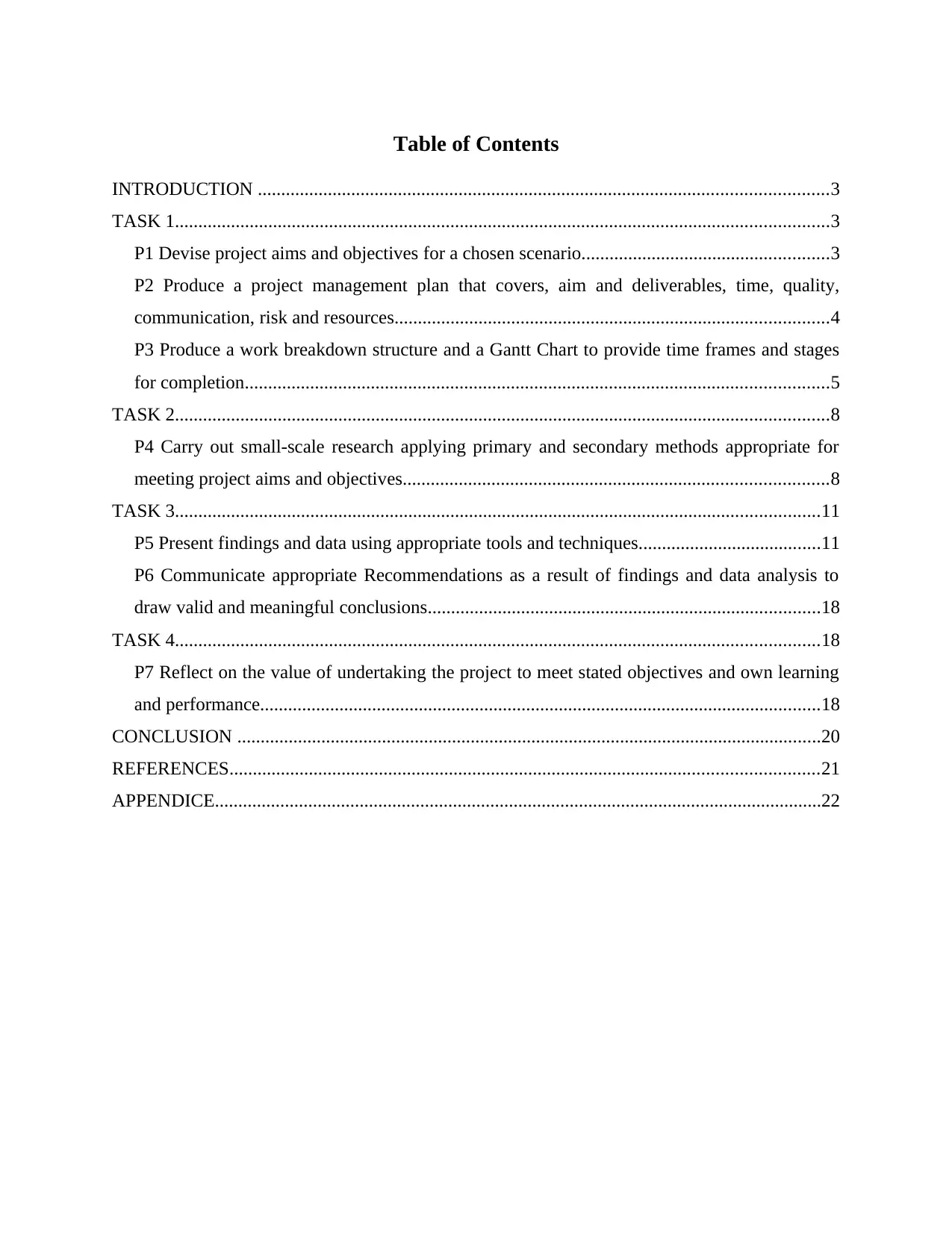
Table of Contents
INTRODUCTION ..........................................................................................................................3
TASK 1............................................................................................................................................3
P1 Devise project aims and objectives for a chosen scenario.....................................................3
P2 Produce a project management plan that covers, aim and deliverables, time, quality,
communication, risk and resources.............................................................................................4
P3 Produce a work breakdown structure and a Gantt Chart to provide time frames and stages
for completion.............................................................................................................................5
TASK 2............................................................................................................................................8
P4 Carry out small-scale research applying primary and secondary methods appropriate for
meeting project aims and objectives...........................................................................................8
TASK 3..........................................................................................................................................11
P5 Present findings and data using appropriate tools and techniques.......................................11
P6 Communicate appropriate Recommendations as a result of findings and data analysis to
draw valid and meaningful conclusions....................................................................................18
TASK 4..........................................................................................................................................18
P7 Reflect on the value of undertaking the project to meet stated objectives and own learning
and performance........................................................................................................................18
CONCLUSION .............................................................................................................................20
REFERENCES..............................................................................................................................21
APPENDICE..................................................................................................................................22
INTRODUCTION ..........................................................................................................................3
TASK 1............................................................................................................................................3
P1 Devise project aims and objectives for a chosen scenario.....................................................3
P2 Produce a project management plan that covers, aim and deliverables, time, quality,
communication, risk and resources.............................................................................................4
P3 Produce a work breakdown structure and a Gantt Chart to provide time frames and stages
for completion.............................................................................................................................5
TASK 2............................................................................................................................................8
P4 Carry out small-scale research applying primary and secondary methods appropriate for
meeting project aims and objectives...........................................................................................8
TASK 3..........................................................................................................................................11
P5 Present findings and data using appropriate tools and techniques.......................................11
P6 Communicate appropriate Recommendations as a result of findings and data analysis to
draw valid and meaningful conclusions....................................................................................18
TASK 4..........................................................................................................................................18
P7 Reflect on the value of undertaking the project to meet stated objectives and own learning
and performance........................................................................................................................18
CONCLUSION .............................................................................................................................20
REFERENCES..............................................................................................................................21
APPENDICE..................................................................................................................................22
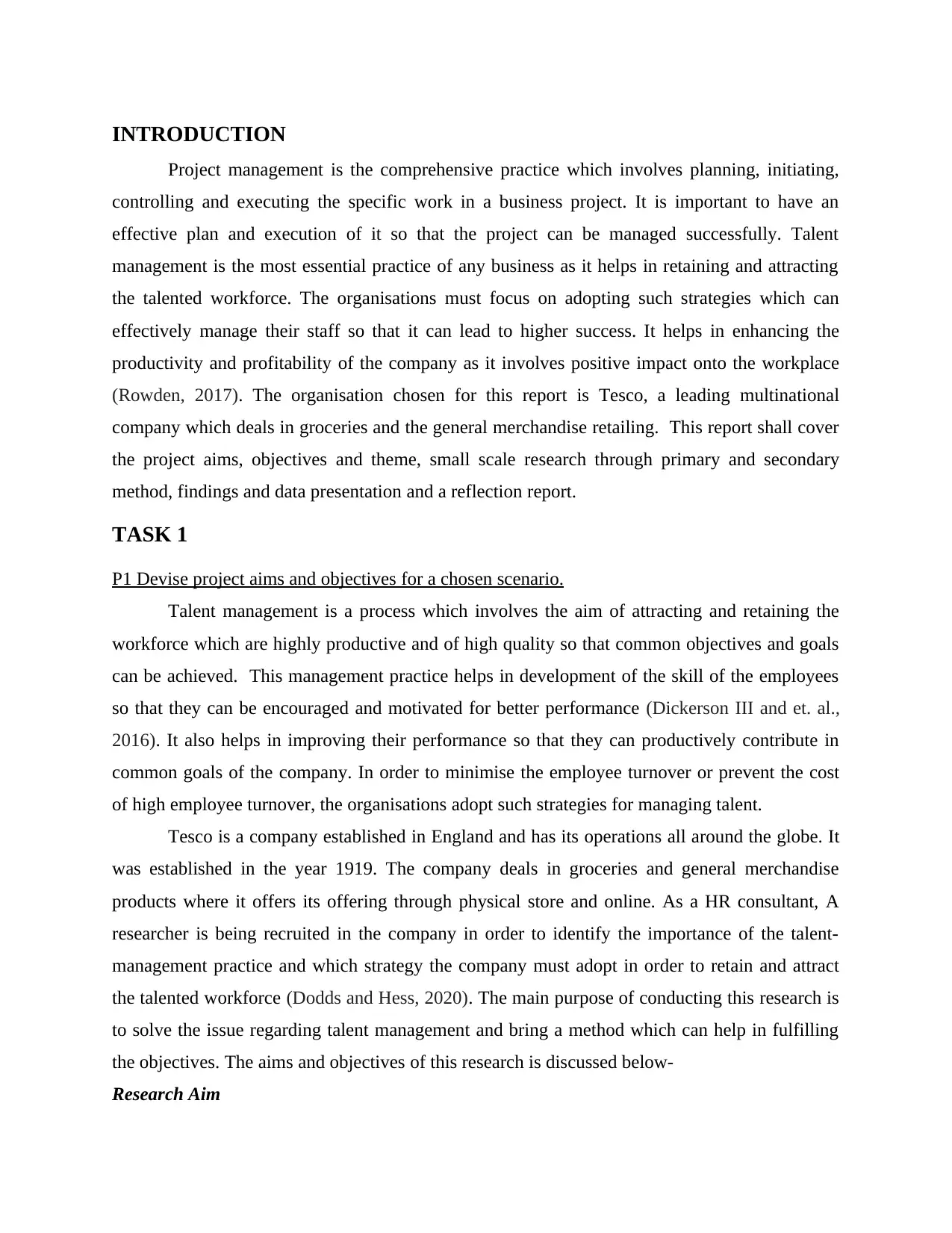
INTRODUCTION
Project management is the comprehensive practice which involves planning, initiating,
controlling and executing the specific work in a business project. It is important to have an
effective plan and execution of it so that the project can be managed successfully. Talent
management is the most essential practice of any business as it helps in retaining and attracting
the talented workforce. The organisations must focus on adopting such strategies which can
effectively manage their staff so that it can lead to higher success. It helps in enhancing the
productivity and profitability of the company as it involves positive impact onto the workplace
(Rowden, 2017). The organisation chosen for this report is Tesco, a leading multinational
company which deals in groceries and the general merchandise retailing. This report shall cover
the project aims, objectives and theme, small scale research through primary and secondary
method, findings and data presentation and a reflection report.
TASK 1
P1 Devise project aims and objectives for a chosen scenario.
Talent management is a process which involves the aim of attracting and retaining the
workforce which are highly productive and of high quality so that common objectives and goals
can be achieved. This management practice helps in development of the skill of the employees
so that they can be encouraged and motivated for better performance (Dickerson III and et. al.,
2016). It also helps in improving their performance so that they can productively contribute in
common goals of the company. In order to minimise the employee turnover or prevent the cost
of high employee turnover, the organisations adopt such strategies for managing talent.
Tesco is a company established in England and has its operations all around the globe. It
was established in the year 1919. The company deals in groceries and general merchandise
products where it offers its offering through physical store and online. As a HR consultant, A
researcher is being recruited in the company in order to identify the importance of the talent-
management practice and which strategy the company must adopt in order to retain and attract
the talented workforce (Dodds and Hess, 2020). The main purpose of conducting this research is
to solve the issue regarding talent management and bring a method which can help in fulfilling
the objectives. The aims and objectives of this research is discussed below-
Research Aim
Project management is the comprehensive practice which involves planning, initiating,
controlling and executing the specific work in a business project. It is important to have an
effective plan and execution of it so that the project can be managed successfully. Talent
management is the most essential practice of any business as it helps in retaining and attracting
the talented workforce. The organisations must focus on adopting such strategies which can
effectively manage their staff so that it can lead to higher success. It helps in enhancing the
productivity and profitability of the company as it involves positive impact onto the workplace
(Rowden, 2017). The organisation chosen for this report is Tesco, a leading multinational
company which deals in groceries and the general merchandise retailing. This report shall cover
the project aims, objectives and theme, small scale research through primary and secondary
method, findings and data presentation and a reflection report.
TASK 1
P1 Devise project aims and objectives for a chosen scenario.
Talent management is a process which involves the aim of attracting and retaining the
workforce which are highly productive and of high quality so that common objectives and goals
can be achieved. This management practice helps in development of the skill of the employees
so that they can be encouraged and motivated for better performance (Dickerson III and et. al.,
2016). It also helps in improving their performance so that they can productively contribute in
common goals of the company. In order to minimise the employee turnover or prevent the cost
of high employee turnover, the organisations adopt such strategies for managing talent.
Tesco is a company established in England and has its operations all around the globe. It
was established in the year 1919. The company deals in groceries and general merchandise
products where it offers its offering through physical store and online. As a HR consultant, A
researcher is being recruited in the company in order to identify the importance of the talent-
management practice and which strategy the company must adopt in order to retain and attract
the talented workforce (Dodds and Hess, 2020). The main purpose of conducting this research is
to solve the issue regarding talent management and bring a method which can help in fulfilling
the objectives. The aims and objectives of this research is discussed below-
Research Aim
⊘ This is a preview!⊘
Do you want full access?
Subscribe today to unlock all pages.

Trusted by 1+ million students worldwide
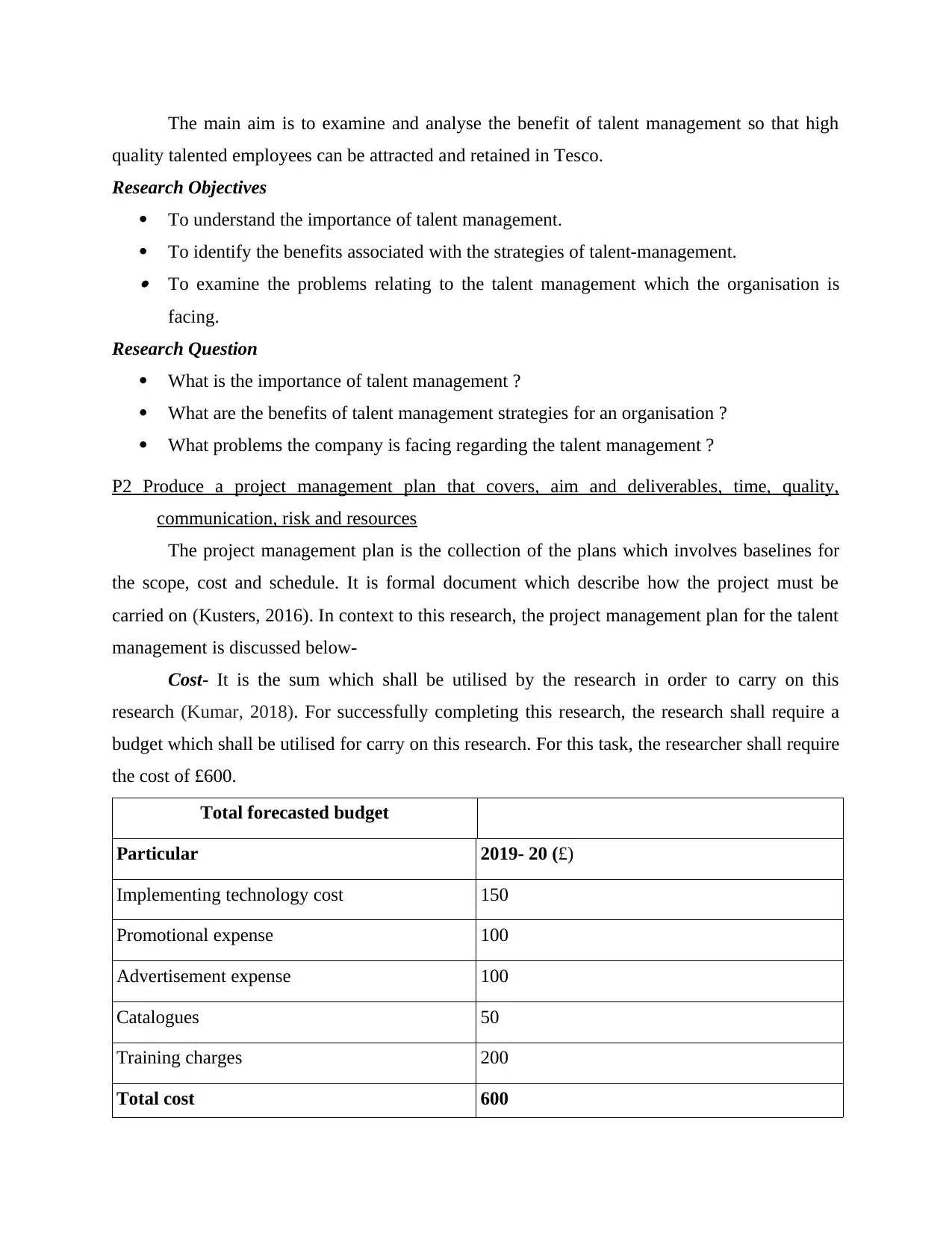
The main aim is to examine and analyse the benefit of talent management so that high
quality talented employees can be attracted and retained in Tesco.
Research Objectives
To understand the importance of talent management.
To identify the benefits associated with the strategies of talent-management. To examine the problems relating to the talent management which the organisation is
facing.
Research Question
What is the importance of talent management ?
What are the benefits of talent management strategies for an organisation ?
What problems the company is facing regarding the talent management ?
P2 Produce a project management plan that covers, aim and deliverables, time, quality,
communication, risk and resources
The project management plan is the collection of the plans which involves baselines for
the scope, cost and schedule. It is formal document which describe how the project must be
carried on (Kusters, 2016). In context to this research, the project management plan for the talent
management is discussed below-
Cost- It is the sum which shall be utilised by the research in order to carry on this
research (Kumar, 2018). For successfully completing this research, the research shall require a
budget which shall be utilised for carry on this research. For this task, the researcher shall require
the cost of £600.
Total forecasted budget
Particular 2019- 20 (£)
Implementing technology cost 150
Promotional expense 100
Advertisement expense 100
Catalogues 50
Training charges 200
Total cost 600
quality talented employees can be attracted and retained in Tesco.
Research Objectives
To understand the importance of talent management.
To identify the benefits associated with the strategies of talent-management. To examine the problems relating to the talent management which the organisation is
facing.
Research Question
What is the importance of talent management ?
What are the benefits of talent management strategies for an organisation ?
What problems the company is facing regarding the talent management ?
P2 Produce a project management plan that covers, aim and deliverables, time, quality,
communication, risk and resources
The project management plan is the collection of the plans which involves baselines for
the scope, cost and schedule. It is formal document which describe how the project must be
carried on (Kusters, 2016). In context to this research, the project management plan for the talent
management is discussed below-
Cost- It is the sum which shall be utilised by the research in order to carry on this
research (Kumar, 2018). For successfully completing this research, the research shall require a
budget which shall be utilised for carry on this research. For this task, the researcher shall require
the cost of £600.
Total forecasted budget
Particular 2019- 20 (£)
Implementing technology cost 150
Promotional expense 100
Advertisement expense 100
Catalogues 50
Training charges 200
Total cost 600
Paraphrase This Document
Need a fresh take? Get an instant paraphrase of this document with our AI Paraphraser
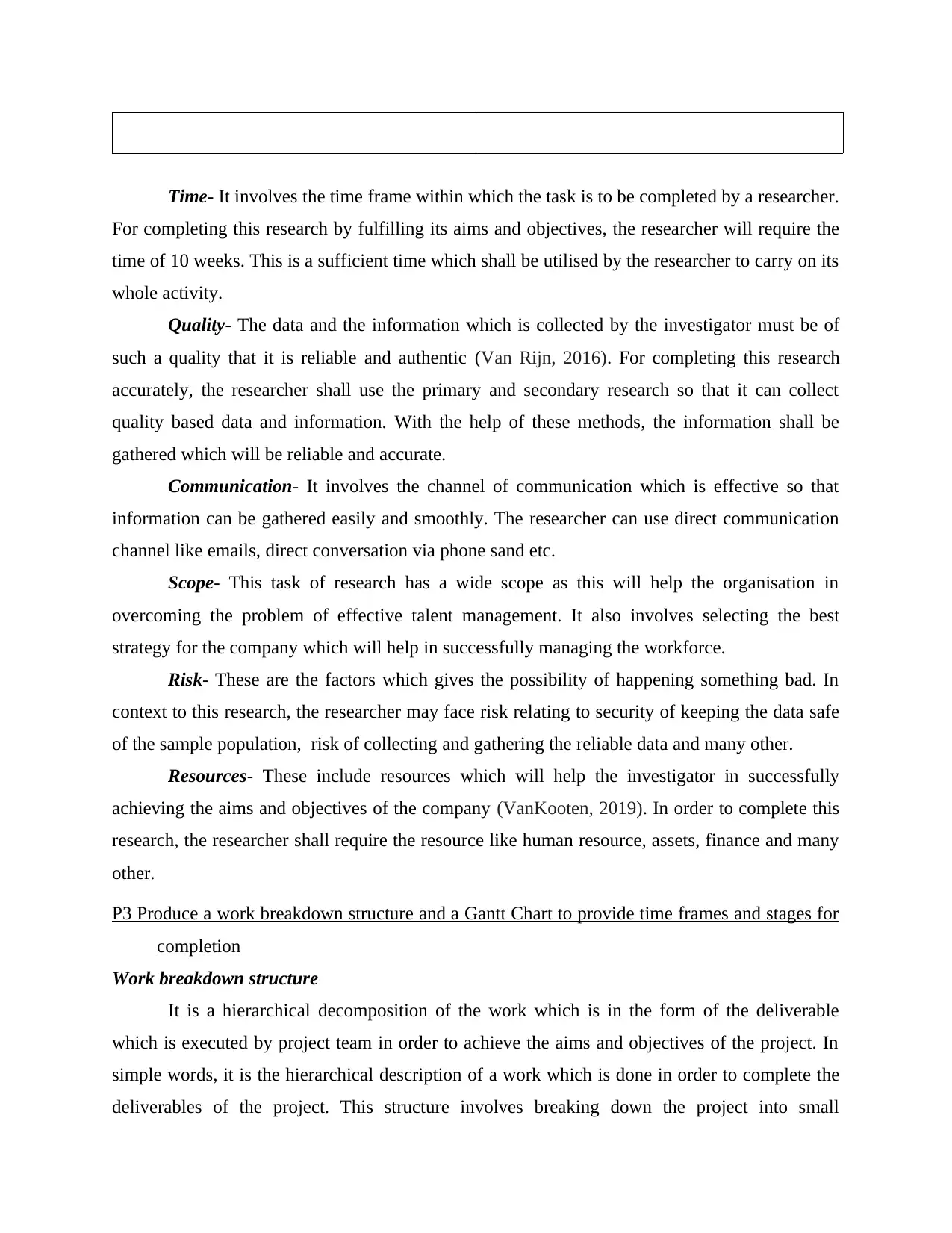
Time- It involves the time frame within which the task is to be completed by a researcher.
For completing this research by fulfilling its aims and objectives, the researcher will require the
time of 10 weeks. This is a sufficient time which shall be utilised by the researcher to carry on its
whole activity.
Quality- The data and the information which is collected by the investigator must be of
such a quality that it is reliable and authentic (Van Rijn, 2016). For completing this research
accurately, the researcher shall use the primary and secondary research so that it can collect
quality based data and information. With the help of these methods, the information shall be
gathered which will be reliable and accurate.
Communication- It involves the channel of communication which is effective so that
information can be gathered easily and smoothly. The researcher can use direct communication
channel like emails, direct conversation via phone sand etc.
Scope- This task of research has a wide scope as this will help the organisation in
overcoming the problem of effective talent management. It also involves selecting the best
strategy for the company which will help in successfully managing the workforce.
Risk- These are the factors which gives the possibility of happening something bad. In
context to this research, the researcher may face risk relating to security of keeping the data safe
of the sample population, risk of collecting and gathering the reliable data and many other.
Resources- These include resources which will help the investigator in successfully
achieving the aims and objectives of the company (VanKooten, 2019). In order to complete this
research, the researcher shall require the resource like human resource, assets, finance and many
other.
P3 Produce a work breakdown structure and a Gantt Chart to provide time frames and stages for
completion
Work breakdown structure
It is a hierarchical decomposition of the work which is in the form of the deliverable
which is executed by project team in order to achieve the aims and objectives of the project. In
simple words, it is the hierarchical description of a work which is done in order to complete the
deliverables of the project. This structure involves breaking down the project into small
For completing this research by fulfilling its aims and objectives, the researcher will require the
time of 10 weeks. This is a sufficient time which shall be utilised by the researcher to carry on its
whole activity.
Quality- The data and the information which is collected by the investigator must be of
such a quality that it is reliable and authentic (Van Rijn, 2016). For completing this research
accurately, the researcher shall use the primary and secondary research so that it can collect
quality based data and information. With the help of these methods, the information shall be
gathered which will be reliable and accurate.
Communication- It involves the channel of communication which is effective so that
information can be gathered easily and smoothly. The researcher can use direct communication
channel like emails, direct conversation via phone sand etc.
Scope- This task of research has a wide scope as this will help the organisation in
overcoming the problem of effective talent management. It also involves selecting the best
strategy for the company which will help in successfully managing the workforce.
Risk- These are the factors which gives the possibility of happening something bad. In
context to this research, the researcher may face risk relating to security of keeping the data safe
of the sample population, risk of collecting and gathering the reliable data and many other.
Resources- These include resources which will help the investigator in successfully
achieving the aims and objectives of the company (VanKooten, 2019). In order to complete this
research, the researcher shall require the resource like human resource, assets, finance and many
other.
P3 Produce a work breakdown structure and a Gantt Chart to provide time frames and stages for
completion
Work breakdown structure
It is a hierarchical decomposition of the work which is in the form of the deliverable
which is executed by project team in order to achieve the aims and objectives of the project. In
simple words, it is the hierarchical description of a work which is done in order to complete the
deliverables of the project. This structure involves breaking down the project into small

components. It helps in organising the work of the team in the manageable section. This structure
is developed so that a better understanding of the project is taken (Li, and Lu, 2017). The work
breakdown structure in context to the current research of talent management for Tesco company
is discussed below-
Gantt Chart
It is a kind of bar chart which illustrate the schedule of the project. This chart is more
popular in showing the activities of the task against the time. At one side, the activities are
placed and at the top the time frame required for each activity to be completed is listed. This
chart helps in assisting the planning and the scheduling of the project (Saputra and Latief, 2020).
Moreover it helps in simplifying the complex projects as well. It is visual representation of the
task which breaks the entire task and then display them on a chart so that it is easily
understandable. In context to current research, the Gantt chart is discussed below-
is developed so that a better understanding of the project is taken (Li, and Lu, 2017). The work
breakdown structure in context to the current research of talent management for Tesco company
is discussed below-
Gantt Chart
It is a kind of bar chart which illustrate the schedule of the project. This chart is more
popular in showing the activities of the task against the time. At one side, the activities are
placed and at the top the time frame required for each activity to be completed is listed. This
chart helps in assisting the planning and the scheduling of the project (Saputra and Latief, 2020).
Moreover it helps in simplifying the complex projects as well. It is visual representation of the
task which breaks the entire task and then display them on a chart so that it is easily
understandable. In context to current research, the Gantt chart is discussed below-
⊘ This is a preview!⊘
Do you want full access?
Subscribe today to unlock all pages.

Trusted by 1+ million students worldwide
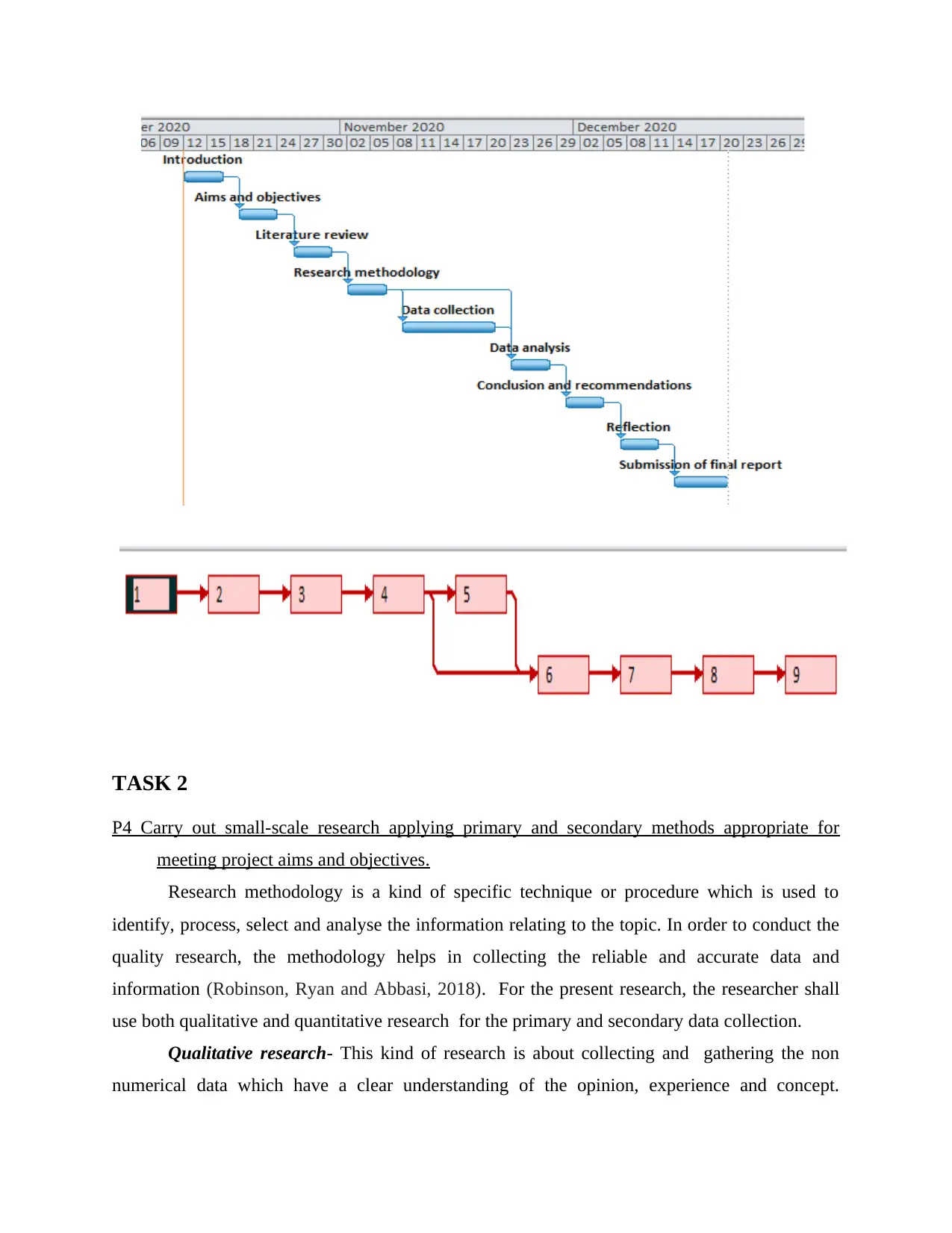
TASK 2
P4 Carry out small-scale research applying primary and secondary methods appropriate for
meeting project aims and objectives.
Research methodology is a kind of specific technique or procedure which is used to
identify, process, select and analyse the information relating to the topic. In order to conduct the
quality research, the methodology helps in collecting the reliable and accurate data and
information (Robinson, Ryan and Abbasi, 2018). For the present research, the researcher shall
use both qualitative and quantitative research for the primary and secondary data collection.
Qualitative research- This kind of research is about collecting and gathering the non
numerical data which have a clear understanding of the opinion, experience and concept.
P4 Carry out small-scale research applying primary and secondary methods appropriate for
meeting project aims and objectives.
Research methodology is a kind of specific technique or procedure which is used to
identify, process, select and analyse the information relating to the topic. In order to conduct the
quality research, the methodology helps in collecting the reliable and accurate data and
information (Robinson, Ryan and Abbasi, 2018). For the present research, the researcher shall
use both qualitative and quantitative research for the primary and secondary data collection.
Qualitative research- This kind of research is about collecting and gathering the non
numerical data which have a clear understanding of the opinion, experience and concept.
Paraphrase This Document
Need a fresh take? Get an instant paraphrase of this document with our AI Paraphraser
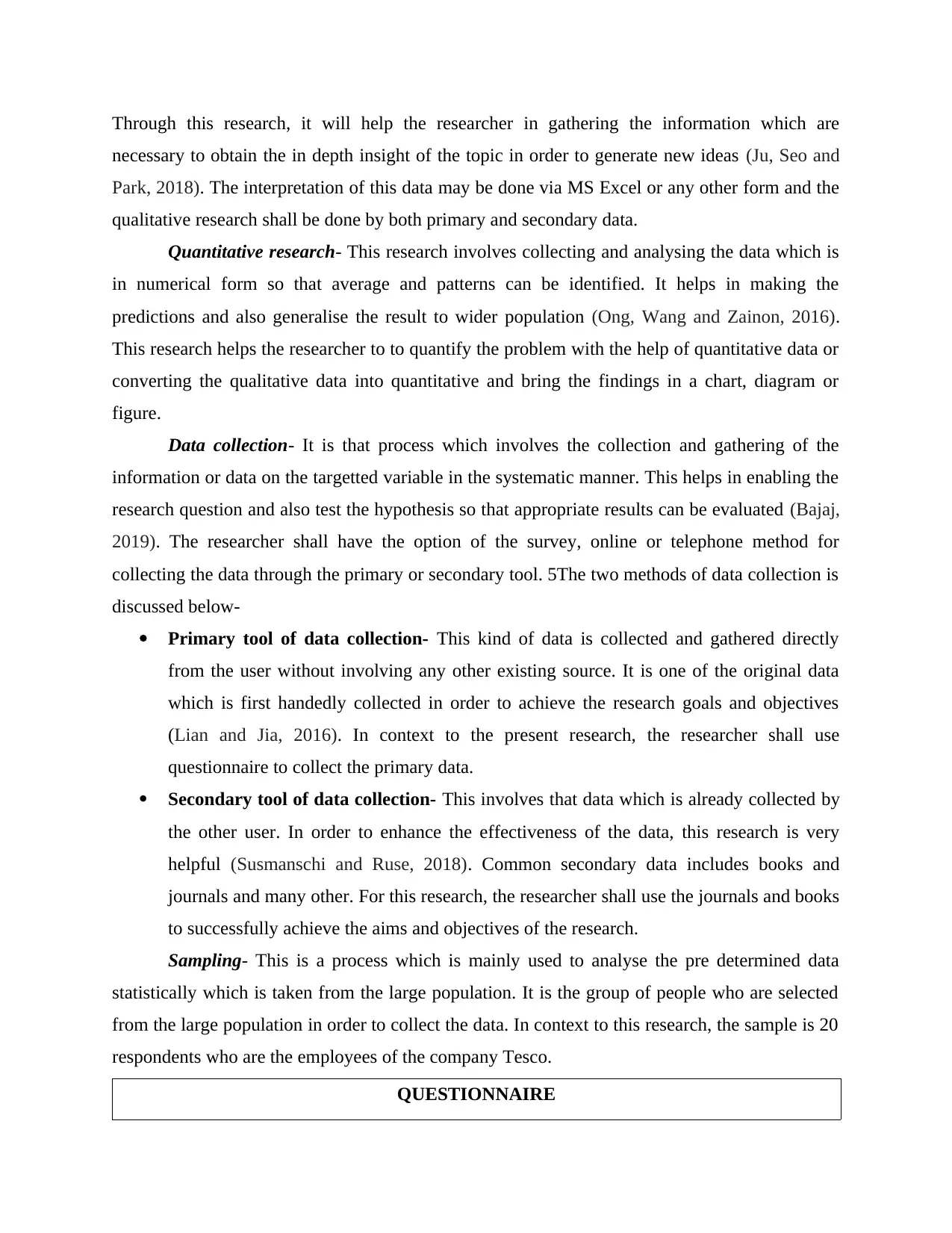
Through this research, it will help the researcher in gathering the information which are
necessary to obtain the in depth insight of the topic in order to generate new ideas (Ju, Seo and
Park, 2018). The interpretation of this data may be done via MS Excel or any other form and the
qualitative research shall be done by both primary and secondary data.
Quantitative research- This research involves collecting and analysing the data which is
in numerical form so that average and patterns can be identified. It helps in making the
predictions and also generalise the result to wider population (Ong, Wang and Zainon, 2016).
This research helps the researcher to to quantify the problem with the help of quantitative data or
converting the qualitative data into quantitative and bring the findings in a chart, diagram or
figure.
Data collection- It is that process which involves the collection and gathering of the
information or data on the targetted variable in the systematic manner. This helps in enabling the
research question and also test the hypothesis so that appropriate results can be evaluated (Bajaj,
2019). The researcher shall have the option of the survey, online or telephone method for
collecting the data through the primary or secondary tool. 5The two methods of data collection is
discussed below-
Primary tool of data collection- This kind of data is collected and gathered directly
from the user without involving any other existing source. It is one of the original data
which is first handedly collected in order to achieve the research goals and objectives
(Lian and Jia, 2016). In context to the present research, the researcher shall use
questionnaire to collect the primary data.
Secondary tool of data collection- This involves that data which is already collected by
the other user. In order to enhance the effectiveness of the data, this research is very
helpful (Susmanschi and Ruse, 2018). Common secondary data includes books and
journals and many other. For this research, the researcher shall use the journals and books
to successfully achieve the aims and objectives of the research.
Sampling- This is a process which is mainly used to analyse the pre determined data
statistically which is taken from the large population. It is the group of people who are selected
from the large population in order to collect the data. In context to this research, the sample is 20
respondents who are the employees of the company Tesco.
QUESTIONNAIRE
necessary to obtain the in depth insight of the topic in order to generate new ideas (Ju, Seo and
Park, 2018). The interpretation of this data may be done via MS Excel or any other form and the
qualitative research shall be done by both primary and secondary data.
Quantitative research- This research involves collecting and analysing the data which is
in numerical form so that average and patterns can be identified. It helps in making the
predictions and also generalise the result to wider population (Ong, Wang and Zainon, 2016).
This research helps the researcher to to quantify the problem with the help of quantitative data or
converting the qualitative data into quantitative and bring the findings in a chart, diagram or
figure.
Data collection- It is that process which involves the collection and gathering of the
information or data on the targetted variable in the systematic manner. This helps in enabling the
research question and also test the hypothesis so that appropriate results can be evaluated (Bajaj,
2019). The researcher shall have the option of the survey, online or telephone method for
collecting the data through the primary or secondary tool. 5The two methods of data collection is
discussed below-
Primary tool of data collection- This kind of data is collected and gathered directly
from the user without involving any other existing source. It is one of the original data
which is first handedly collected in order to achieve the research goals and objectives
(Lian and Jia, 2016). In context to the present research, the researcher shall use
questionnaire to collect the primary data.
Secondary tool of data collection- This involves that data which is already collected by
the other user. In order to enhance the effectiveness of the data, this research is very
helpful (Susmanschi and Ruse, 2018). Common secondary data includes books and
journals and many other. For this research, the researcher shall use the journals and books
to successfully achieve the aims and objectives of the research.
Sampling- This is a process which is mainly used to analyse the pre determined data
statistically which is taken from the large population. It is the group of people who are selected
from the large population in order to collect the data. In context to this research, the sample is 20
respondents who are the employees of the company Tesco.
QUESTIONNAIRE
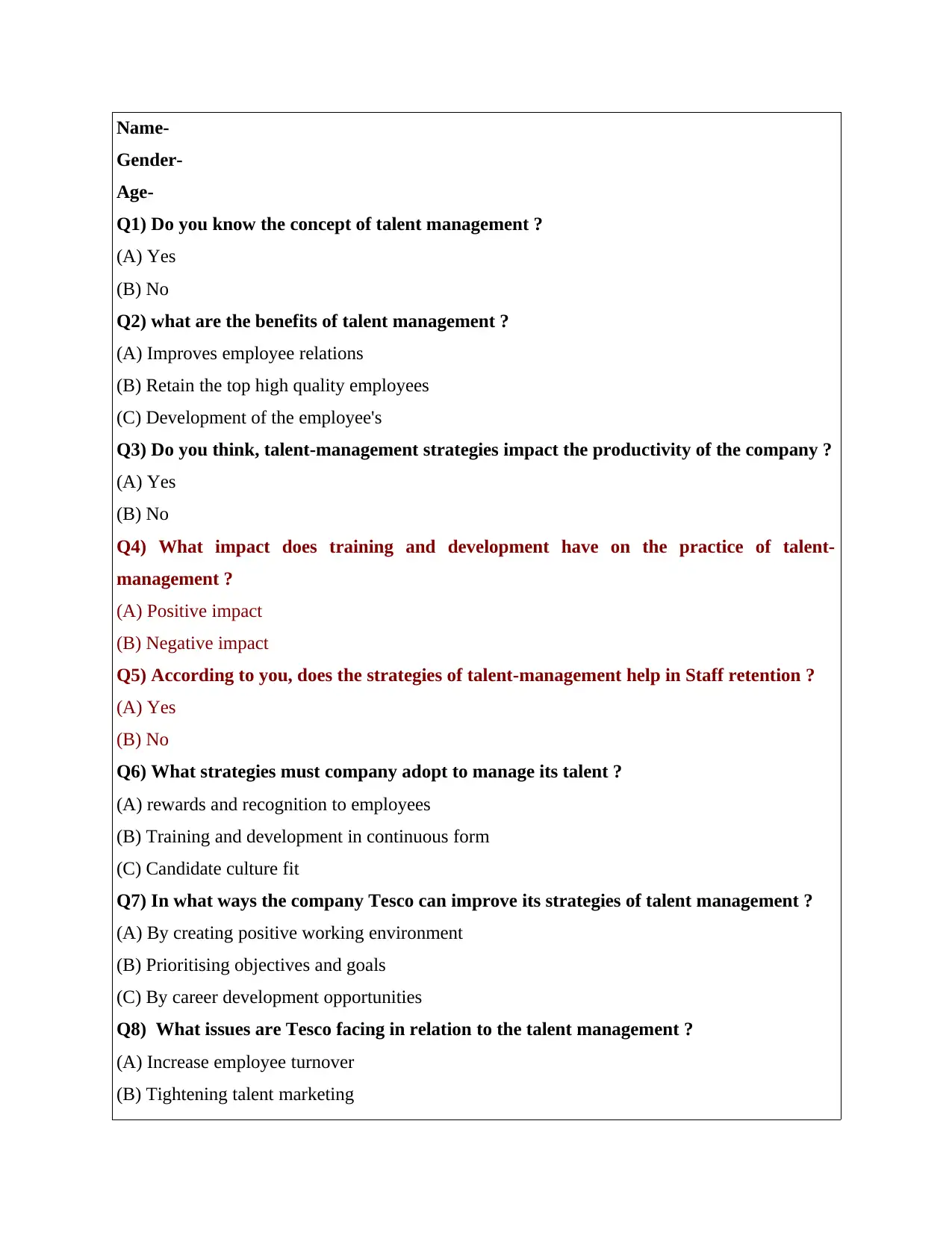
Name-
Gender-
Age-
Q1) Do you know the concept of talent management ?
(A) Yes
(B) No
Q2) what are the benefits of talent management ?
(A) Improves employee relations
(B) Retain the top high quality employees
(C) Development of the employee's
Q3) Do you think, talent-management strategies impact the productivity of the company ?
(A) Yes
(B) No
Q4) What impact does training and development have on the practice of talent-
management ?
(A) Positive impact
(B) Negative impact
Q5) According to you, does the strategies of talent-management help in Staff retention ?
(A) Yes
(B) No
Q6) What strategies must company adopt to manage its talent ?
(A) rewards and recognition to employees
(B) Training and development in continuous form
(C) Candidate culture fit
Q7) In what ways the company Tesco can improve its strategies of talent management ?
(A) By creating positive working environment
(B) Prioritising objectives and goals
(C) By career development opportunities
Q8) What issues are Tesco facing in relation to the talent management ?
(A) Increase employee turnover
(B) Tightening talent marketing
Gender-
Age-
Q1) Do you know the concept of talent management ?
(A) Yes
(B) No
Q2) what are the benefits of talent management ?
(A) Improves employee relations
(B) Retain the top high quality employees
(C) Development of the employee's
Q3) Do you think, talent-management strategies impact the productivity of the company ?
(A) Yes
(B) No
Q4) What impact does training and development have on the practice of talent-
management ?
(A) Positive impact
(B) Negative impact
Q5) According to you, does the strategies of talent-management help in Staff retention ?
(A) Yes
(B) No
Q6) What strategies must company adopt to manage its talent ?
(A) rewards and recognition to employees
(B) Training and development in continuous form
(C) Candidate culture fit
Q7) In what ways the company Tesco can improve its strategies of talent management ?
(A) By creating positive working environment
(B) Prioritising objectives and goals
(C) By career development opportunities
Q8) What issues are Tesco facing in relation to the talent management ?
(A) Increase employee turnover
(B) Tightening talent marketing
⊘ This is a preview!⊘
Do you want full access?
Subscribe today to unlock all pages.

Trusted by 1+ million students worldwide
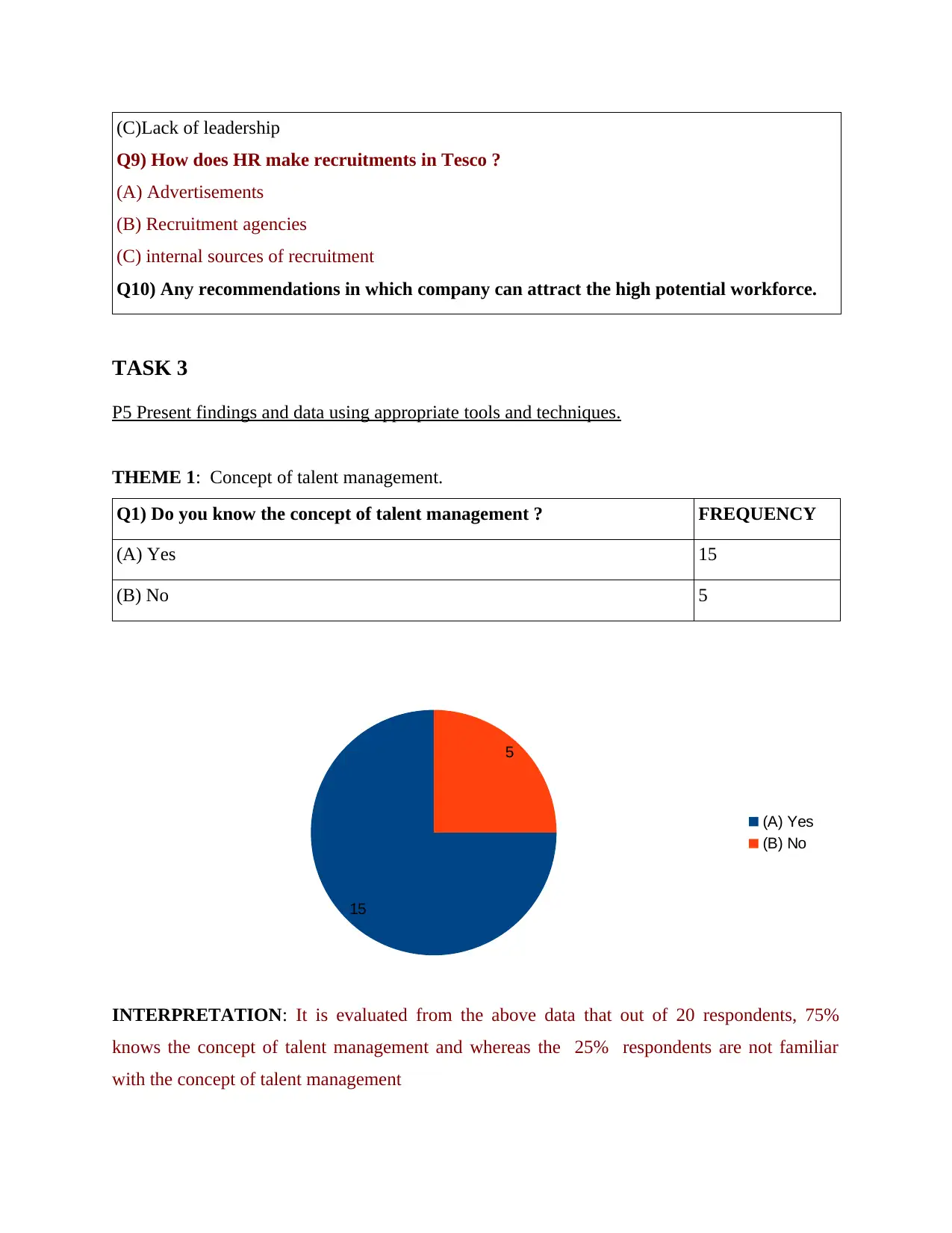
(C)Lack of leadership
Q9) How does HR make recruitments in Tesco ?
(A) Advertisements
(B) Recruitment agencies
(C) internal sources of recruitment
Q10) Any recommendations in which company can attract the high potential workforce.
TASK 3
P5 Present findings and data using appropriate tools and techniques.
THEME 1: Concept of talent management.
Q1) Do you know the concept of talent management ? FREQUENCY
(A) Yes 15
(B) No 5
INTERPRETATION: It is evaluated from the above data that out of 20 respondents, 75%
knows the concept of talent management and whereas the 25% respondents are not familiar
with the concept of talent management
15
5
(A) Yes
(B) No
Q9) How does HR make recruitments in Tesco ?
(A) Advertisements
(B) Recruitment agencies
(C) internal sources of recruitment
Q10) Any recommendations in which company can attract the high potential workforce.
TASK 3
P5 Present findings and data using appropriate tools and techniques.
THEME 1: Concept of talent management.
Q1) Do you know the concept of talent management ? FREQUENCY
(A) Yes 15
(B) No 5
INTERPRETATION: It is evaluated from the above data that out of 20 respondents, 75%
knows the concept of talent management and whereas the 25% respondents are not familiar
with the concept of talent management
15
5
(A) Yes
(B) No
Paraphrase This Document
Need a fresh take? Get an instant paraphrase of this document with our AI Paraphraser
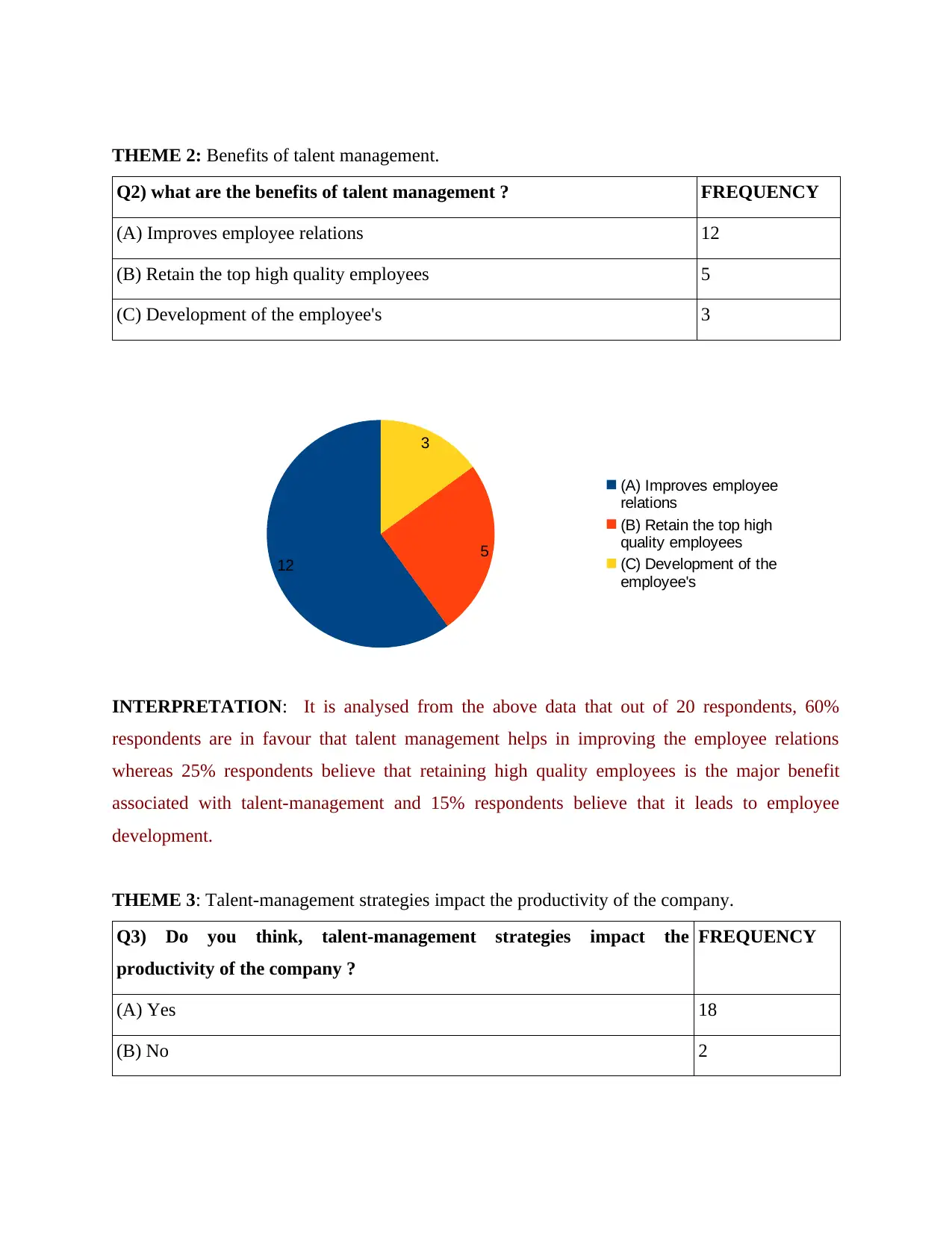
THEME 2: Benefits of talent management.
Q2) what are the benefits of talent management ? FREQUENCY
(A) Improves employee relations 12
(B) Retain the top high quality employees 5
(C) Development of the employee's 3
INTERPRETATION: It is analysed from the above data that out of 20 respondents, 60%
respondents are in favour that talent management helps in improving the employee relations
whereas 25% respondents believe that retaining high quality employees is the major benefit
associated with talent-management and 15% respondents believe that it leads to employee
development.
THEME 3: Talent-management strategies impact the productivity of the company.
Q3) Do you think, talent-management strategies impact the
productivity of the company ?
FREQUENCY
(A) Yes 18
(B) No 2
12 5
3
(A) Improves employee
relations
(B) Retain the top high
quality employees
(C) Development of the
employee's
Q2) what are the benefits of talent management ? FREQUENCY
(A) Improves employee relations 12
(B) Retain the top high quality employees 5
(C) Development of the employee's 3
INTERPRETATION: It is analysed from the above data that out of 20 respondents, 60%
respondents are in favour that talent management helps in improving the employee relations
whereas 25% respondents believe that retaining high quality employees is the major benefit
associated with talent-management and 15% respondents believe that it leads to employee
development.
THEME 3: Talent-management strategies impact the productivity of the company.
Q3) Do you think, talent-management strategies impact the
productivity of the company ?
FREQUENCY
(A) Yes 18
(B) No 2
12 5
3
(A) Improves employee
relations
(B) Retain the top high
quality employees
(C) Development of the
employee's
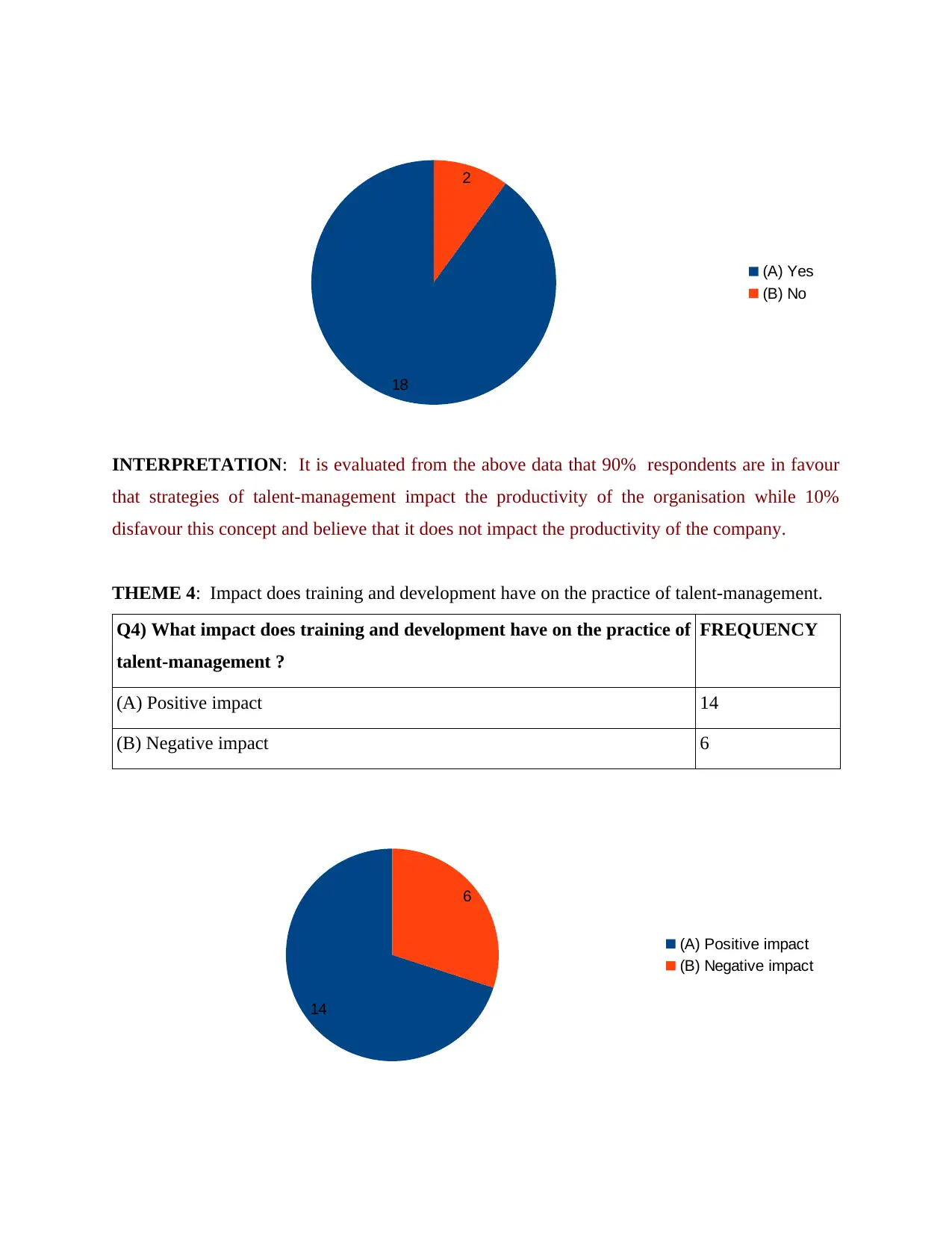
INTERPRETATION: It is evaluated from the above data that 90% respondents are in favour
that strategies of talent-management impact the productivity of the organisation while 10%
disfavour this concept and believe that it does not impact the productivity of the company.
THEME 4: Impact does training and development have on the practice of talent-management.
Q4) What impact does training and development have on the practice of
talent-management ?
FREQUENCY
(A) Positive impact 14
(B) Negative impact 6
18
2
(A) Yes
(B) No
14
6
(A) Positive impact
(B) Negative impact
that strategies of talent-management impact the productivity of the organisation while 10%
disfavour this concept and believe that it does not impact the productivity of the company.
THEME 4: Impact does training and development have on the practice of talent-management.
Q4) What impact does training and development have on the practice of
talent-management ?
FREQUENCY
(A) Positive impact 14
(B) Negative impact 6
18
2
(A) Yes
(B) No
14
6
(A) Positive impact
(B) Negative impact
⊘ This is a preview!⊘
Do you want full access?
Subscribe today to unlock all pages.

Trusted by 1+ million students worldwide
1 out of 23
Related Documents
Your All-in-One AI-Powered Toolkit for Academic Success.
+13062052269
info@desklib.com
Available 24*7 on WhatsApp / Email
![[object Object]](/_next/static/media/star-bottom.7253800d.svg)
Unlock your academic potential
© 2024 | Zucol Services PVT LTD | All rights reserved.





